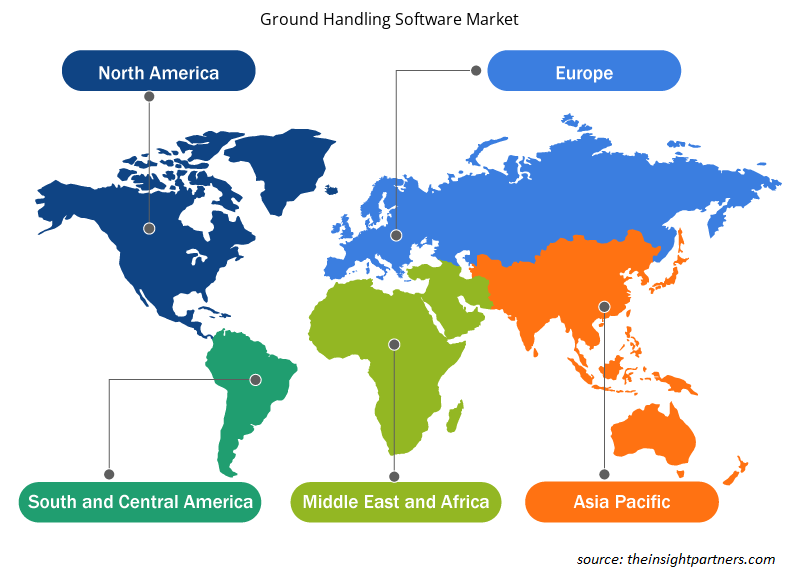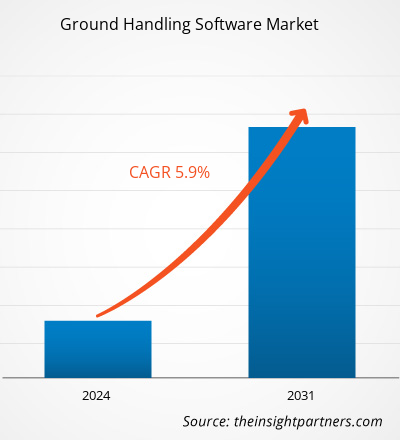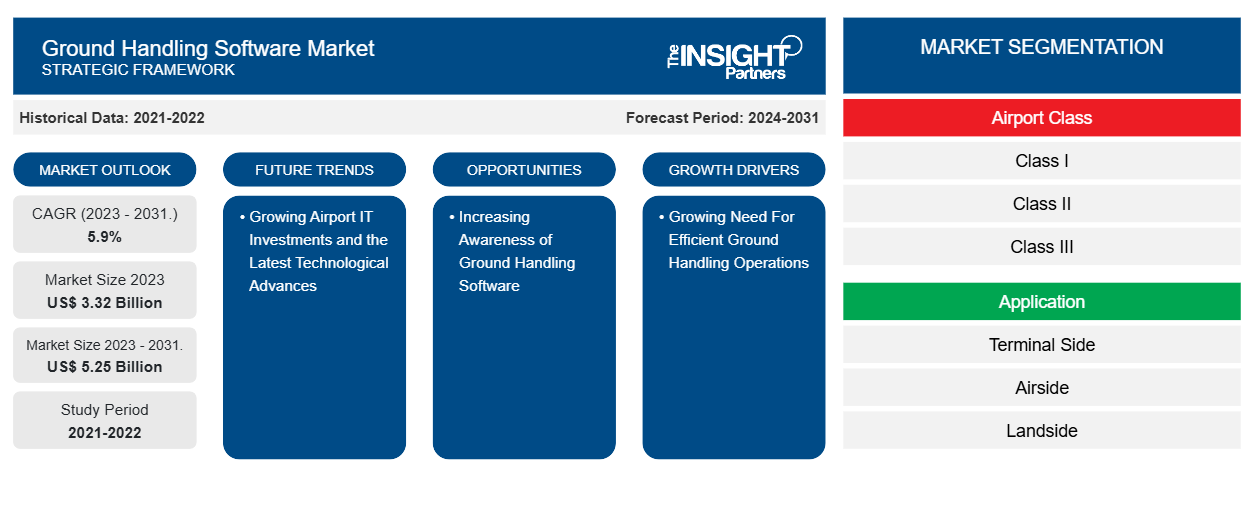Le marché des logiciels de manutention au sol devrait atteindre 5,25 milliards USD d'ici 2031, contre 3,32 milliards USD en 2023. Le marché devrait enregistrer un TCAC de 5,9 % au cours de la période 2023-2031. Les investissements croissants dans les technologies de l'information des aéroports et les dernières avancées technologiques devraient rester une tendance clé du marché.CAGR of 5.9% during 2023–2031. Growing airport IT investments and the latest technological advances are likely to remain a key trend in the market.
Analyse du marché des logiciels de manutention au sol
La demande de logiciels de gestion au sol ne cesse d'augmenter en raison des avancées technologiques et du désir d'une exploitation aéroportuaire efficace. La mise en œuvre de systèmes numériques incluant l'automatisation, l'analyse de données et le cloud computing pour optimiser les procédures de gestion au sol est en hausse. En outre, la volonté d'injecter de nouvelles technologies et de nouveaux systèmes opérationnels dans le secteur est motivée par un environnement réglementaire de sécurité strict et une interaction accrue des passagers en libre-service.
Aperçu du marché des logiciels de manutention au sol
Le logiciel de gestion au sol est un système qui permet de fournir rapidement et de la meilleure façon possible tous les services effectués à bord de l'avion. Il s'agit notamment du ravitaillement en carburant, de la restauration, de la gestion des bagages et de la maintenance des avions. Le logiciel de gestion au sol est la mesure ultime qui a permis aux prestataires de services de disposer de carburant supplémentaire et d'une vitesse de croisière accrue, ce qui est crucial pour réduire le temps de rotation des avions et donc augmenter les revenus.
Personnalisez ce rapport en fonction de vos besoins
Vous bénéficierez d'une personnalisation gratuite de n'importe quel rapport, y compris de certaines parties de ce rapport, d'une analyse au niveau des pays, d'un pack de données Excel, ainsi que de superbes offres et réductions pour les start-ups et les universités.
-
Obtenez les principales tendances clés du marché de ce rapport.Cet échantillon GRATUIT comprendra une analyse de données, allant des tendances du marché aux estimations et prévisions.
Moteurs et opportunités du marché des logiciels de manutention au sol
Besoin croissant d'opérations de manutention au sol efficaces
La demande croissante de gestion efficace des opérations au sol dans les aéroports est motivée par la nécessité de réduire les coûts opérationnels et d'améliorer la satisfaction des clients. Les aéroports connaissant une augmentation alarmante de la congestion, les compagnies aériennes recherchent actuellement des moyens de réduire les délais d'exécution, d'améliorer la précision des opérations de manutention et de réduire les retards. Les logiciels de manutention au sol sont la solution qui permet aux compagnies aériennes de gérer facilement les activités au sol, réduisant ainsi les coûts opérationnels et améliorant l'expérience client. La technologie facilite les procédures de manutention et aide une compagnie aérienne à se préparer à l'avance à l'adversité d'un trafic aérien croissant dans un environnement opérationnel hautement efficace et orienté client.
Sensibilisation accrue aux logiciels de gestion au sol
La prise de conscience croissante des avantages que peuvent apporter les logiciels de manutention au sol et l'adoption de l'automatisation et de la technologie dans les opérations de manutention au sol ne cesse de croître. Conscientes de la compétitivité d'un secteur, les compagnies aériennes cherchent des moyens d'améliorer la productivité opérationnelle tout en réduisant les coûts en étant sensibles au prix. Les logiciels de manutention au sol offrent aux compagnies aériennes les moyens d'automatiser la majorité de leurs opérations de manutention au sol, ce qui réduit donc les coûts généraux et améliore l'efficacité opérationnelle. La prise de conscience croissante de ces avantages alimente en fait le taux d'adoption des logiciels de manutention au sol dans les aéroports.
Analyse de segmentation du rapport sur le marché des logiciels de manutention au sol
Les segments clés qui ont contribué à l’élaboration de l’analyse du marché des logiciels d’escale sont la classe d’aéroport, l’application et le type de logiciel.
- En fonction de la classe de l'aéroport, le marché est segmenté en classe I, classe II, classe III et classe IV. Le segment de classe I détenait une part de marché importante en 2023.
- En termes d'application, le marché est segmenté en côté terminal, côté piste et côté ville. Le segment côté terminal détenait une part de marché importante en 2023.airside, and landside. The terminal side segment held a significant market share in 2023.
- En fonction du type de logiciel, le marché est segmenté en contrôle d'embarquement et de départ des passagers, gestion des bagages, contrôle automatisé du fret et de la charge, suivi GSE (télémétrie) et gestion des rampes. Le segment de la gestion des bagages détenait une part de marché importante en 2023.GSE tracking (telemetry), and ramp management. The baggage management segment held a significant market share in 2023.
Analyse des parts de marché des logiciels de manutention au sol par zone géographique
La portée géographique du rapport sur le marché des logiciels de manutention au sol est principalement divisée en cinq régions : Amérique du Nord, Asie-Pacifique, Europe, Moyen-Orient et Afrique, et Amérique du Sud et centrale.
Le marché nord-américain des logiciels de manutention au sol connaît une croissance rapide en raison de la demande croissante de solutions de manutention au sol efficaces et rentables de la part de diverses compagnies aériennes et de divers aéroports. Cette région abrite la majorité des plus grandes compagnies aériennes et des plus grands aéroports du monde, qui investissent massivement dans les logiciels de manutention au sol pour améliorer l'efficacité opérationnelle et réduire les coûts. Le nombre de fournisseurs de logiciels de manutention au sol dans la région a augmenté, ce qui a stimulé la concurrence et l'innovation. Dans l'ensemble, la croissance du marché nord-américain des logiciels de manutention au sol est forte, stimulée par la demande croissante des transporteurs aériens et des aéroports pour des solutions de manutention au sol efficaces et rentables, l'augmentation du nombre de fournisseurs de logiciels de manutention au sol et l'adoption de solutions basées sur le cloud.
Aperçu régional du marché des logiciels de manutention au sol
Les tendances et facteurs régionaux influençant le marché des logiciels de manutention au sol tout au long de la période de prévision ont été expliqués en détail par les analystes d’Insight Partners. Cette section traite également des segments et de la géographie du marché des logiciels de manutention au sol en Amérique du Nord, en Europe, en Asie-Pacifique, au Moyen-Orient et en Afrique, ainsi qu’en Amérique du Sud et en Amérique centrale.

- Obtenez les données régionales spécifiques au marché des logiciels de manutention au sol
Portée du rapport sur le marché des logiciels de manutention au sol
| Attribut de rapport | Détails |
|---|---|
| Taille du marché en 2023 | 3,32 milliards de dollars américains |
| Taille du marché d'ici 2031 | 5,25 milliards de dollars américains |
| TCAC mondial (2023 - 2031.) | 5,9% |
| Données historiques | 2021-2022 |
| Période de prévision | 2024-2031 |
| Segments couverts |
Par classe d'aéroport
|
| Régions et pays couverts |
Amérique du Nord
|
| Leaders du marché et profils d'entreprises clés |
|
Densité des acteurs du marché des logiciels de gestion d'escale : comprendre son impact sur la dynamique des entreprises
Le marché des logiciels de manutention au sol connaît une croissance rapide, tirée par la demande croissante des utilisateurs finaux en raison de facteurs tels que l'évolution des préférences des consommateurs, les avancées technologiques et une plus grande sensibilisation aux avantages du produit. À mesure que la demande augmente, les entreprises élargissent leurs offres, innovent pour répondre aux besoins des consommateurs et capitalisent sur les tendances émergentes, ce qui alimente davantage la croissance du marché.
La densité des acteurs du marché fait référence à la répartition des entreprises ou des sociétés opérant sur un marché ou un secteur particulier. Elle indique le nombre de concurrents (acteurs du marché) présents sur un marché donné par rapport à sa taille ou à sa valeur marchande totale.
Les principales entreprises opérant sur le marché des logiciels de manutention au sol sont :
- Arepo Solutions Ltd.
- Avtura Limitée
- Damarel Systems International Ltée.
- INFORM GmbH
- Solutions d'aviation quantiques
- Quonext
Avis de non-responsabilité : les sociétés répertoriées ci-dessus ne sont pas classées dans un ordre particulier.

- Obtenez un aperçu des principaux acteurs du marché des logiciels de manutention au sol
Actualités et développements récents du marché des logiciels de manutention au sol
Le marché des logiciels de gestion au sol est évalué en collectant des données qualitatives et quantitatives après des recherches primaires et secondaires, qui comprennent d'importantes publications d'entreprise, des données d'association et des bases de données. Quelques-uns des développements sur le marché des logiciels de gestion au sol sont répertoriés ci-dessous :
- Menzies Aviation, le principal partenaire de services des aéroports et des compagnies aériennes du monde entier, en collaboration avec Wipro, société leader de services technologiques et de conseil, a annoncé le lancement réussi de son nouveau système de gestion de fret Menzies Aviation Cargo Handling (MACH).
(Source : Menzies Aviation Limited, site Web de la société, décembre 2023)
Rapport sur le marché des logiciels de manutention au sol et livrables
Le rapport « Taille et prévisions du marché des logiciels de manutention au sol (2021-2031) » fournit une analyse détaillée du marché couvrant les domaines ci-dessous :
- Taille et prévisions du marché des logiciels de manutention au sol aux niveaux mondial, régional et national pour tous les segments de marché clés couverts par le périmètre
- Tendances du marché des logiciels de manutention au sol ainsi que la dynamique du marché, telles que les facteurs déterminants, les contraintes et les opportunités clés
- Analyse détaillée des cinq forces de PEST/Porter et SWOT
- Analyse du marché des logiciels de manutention au sol couvrant les principales tendances du marché, le cadre mondial et régional, les principaux acteurs, les réglementations et les développements récents du marché
- Analyse du paysage industriel et de la concurrence couvrant la concentration du marché, l'analyse de la carte thermique, les principaux acteurs et les développements récents du marché des logiciels de manutention au sol
- Profils d'entreprise détaillés
- Analyse historique (2 ans), année de base, prévision (7 ans) avec TCAC
- Analyse PEST et SWOT
- Taille du marché Valeur / Volume - Mondial, Régional, Pays
- Industrie et paysage concurrentiel
- Ensemble de données Excel
Rapports récents
Rapports connexes
Témoignages
Raison d'acheter
- Prise de décision éclairée
- Compréhension de la dynamique du marché
- Analyse concurrentielle
- Connaissances clients
- Prévisions de marché
- Atténuation des risques
- Planification stratégique
- Justification des investissements
- Identification des marchés émergents
- Amélioration des stratégies marketing
- Amélioration de l'efficacité opérationnelle
- Alignement sur les tendances réglementaires























 Obtenez un échantillon gratuit pour - Marché des logiciels de manutention au sol
Obtenez un échantillon gratuit pour - Marché des logiciels de manutention au sol